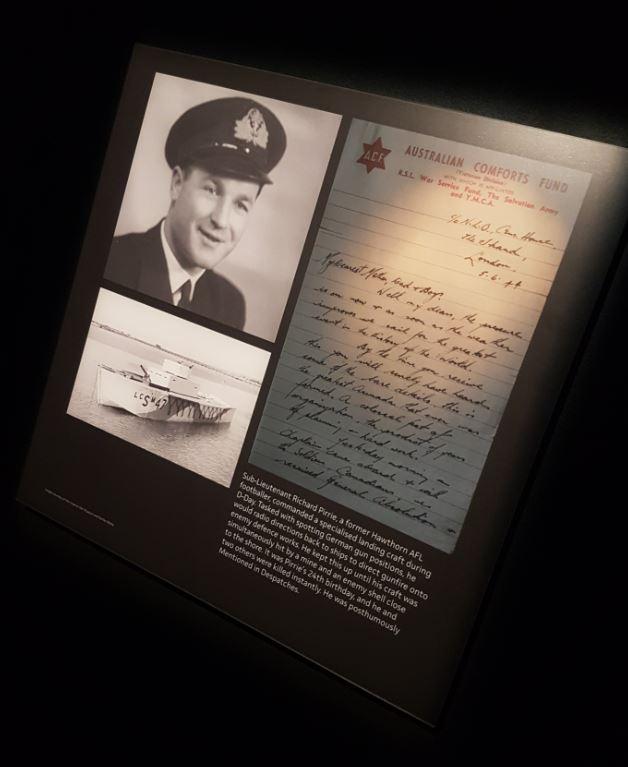'We sail for the greatest event in the history of the world'

On 5 June 1944, Sub-Lieutenant Richard Pirrie sat down to write a letter to his family.
“My dearest mother, Dad, and boys,” he began.
“Well, my dears, the pressure is on now and as soon as the weather improves we sail for the greatest event in the history of the world.
“By the time you receive this you will surely have heard some of the bare details. This is the greatest Armada that ever was formed. A colossal feat of organisation; the product of years of planning and hard work.
“Yesterday morning our chaplain came aboard and with the soldiers, Canadians, we received General Absolution. If anything happens, it is just the will of the Sacred Heart. I will leave this, and hope and trust in God that I will conclude in a few days.”
Pirrie never finished the letter.
The following day, 6 June, he was the first Australian to be killed on D-Day.
Tasked with spotting German gun positions, Pirie was part of the first wave of landing craft to reach Juno Beach during the Allied invasion of Normandy.
Known to his British crewmates as “Digger”, Pirrie had the dangerous job of piloting his landing craft close to the beach so that he could tell a naval artillery observer where to direct gunfire onto the German defences.
He had performed a similar task during the invasion of Sicily the year before, but this time disaster struck.
Pirrie and two others were killed instantly when his landing craft struck a mine and was simultaneously hit by enemy shell-fire close to the shore.
It was his 24th birthday.
A copy of his unfinished letter is on display as part of the Australian War Memorial’s latest exhibition, D-Day: the Australian story, which tells the story of the thousands of Australians who risked their lives to play a part in the liberation of Western Europe 75 years ago.
“D-day has long been thought of as a foreign story – British, French, Canadian, and American – but we know that some 3,300 Australians were involved in the operation,” exhibition curator Shane Casey said.
“We know also that 13 Australians lost their lives just on D-Day itself … It’s one of those events in world history that was a defining moment; it changed the course of the war … and liberated France and Western Europe from Nazi occupation, taking pressure off the Soviet armies in the east, and shortening the war, and what we want to do is tell the Australian side of that story.”
Described by British Prime Minister Winston Churchill as “much the greatest thing … ever attempted”, Operation Overlord was the largest naval, air, and land operation in history, and one of the most significant events of the Second World War.
It was a mammoth undertaking. More than 6,500 Allied ships and landing craft put to sea from ports along the length of the British south coast, supported by 12,000 aircraft.
In the early hours of 6 June 1944, Allied forces stormed ashore the heavily defended beaches of northern France, supported by 24,000 glider-borne troops and paratroopers aboard 1,200 transport aircraft and 700 gliders.
“The whole of the south of England … was just awash with Americans, Canadians, French, Aussies, and Brits,” Casey said.
“The sheer magnitude of it … was profound, and one of the things that really strikes you when you read the accounts of the people who were there is that they all knew that this was the biggest event they were ever going to take part in and that it was one of the greatest events that the world had ever seen.”
Casey said Pirrie’s story was particularly poignant.
The eldest son of six children, “Dick” Pirrie was born in the Melbourne suburb of Hawthorn in 1920 and was studying law when the war broke out.
A talented athlete, he had given up a promising football career with the Hawthorn Football Club when he enlisted in the Royal Australian Navy. He was later seconded to the Royal Navy aboard HMS Invicta.
For his “gallantry, leadership and determination” on D-Day, Pirrie was posthumously Mentioned in Dispatches. He had performed his task with “great skill”, and “his conduct and bearing greatly encouraged his men”.
Robert Raymond, a war correspondent for Sydney’s Daily Mirror who was posted on HMS Invicta and had befriended Pirrie, also wrote of his bravery.
“Digger never had a chance,” he wrote in a report on his friend's death, “but the Canadians fighting ashore today know what he did – and won't forget.”
A fellow officer, Lieutenant Tom Longford, wrote to Pirrie’s mother to express his deepest sympathy.
Pirrie, he wrote, had performed his duty “so courageously and efficiently” that “on our portion of the beach not one of our troops failed to get safely ashore”.
“The whole flotilla is deeply grieved by the loss of so deeply loved and much respected friend,” he wrote. “His friendly nature, cheerful, willing devotion to all his duties, and his firm belief in the ultimate good of all things made him an officer with whom we are all proud to have served.”
Today, Pirrie’s name is commemorated on the Plymouth Naval Memorial, which lists the names of 15,993 sailors of the British Commonwealth who were lost at sea.
A newspaper article published at the time reported that the first to know of his death was his sister: “The only one fully in on the secret was little Helen, only sister of Richard … who died on Armistice day some years ago. Like Helen, her sailor brother found his Armistice betimes … Heaven now was his.”
His mother was left devastated. “Richard got up laughing and went to bed laughing,” she was quoted as saying. “He was an ideal son and brother.”
D-Day: the Australian story is on display in the mezzanine area of Anzac Hall until September 2019. For more information about Australians on D-Day, visit here.